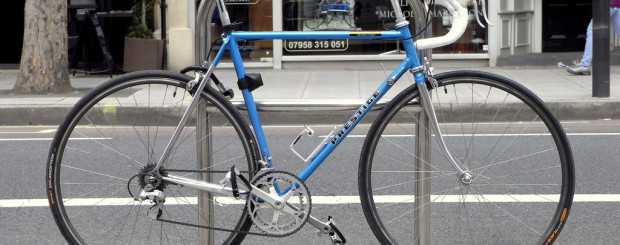How To Stop Your Bike From Being Stolen In London
With the traffic in London becoming evermore busy, swopping four wheels for two has become one of the best ways to travel around the capital. Not to mention that cycling everywhere is great for your fitness levels.
But sadly, as cycling becomes more popular, it’s offered a growing opportunity for the bike thieves to move into action. But never fear, because there are plenty of ways that you can reduce the chances of your bike from being stolen in London.
With a little bit of forethought and planning, you can pretty much ensure that your method of transport remains safely where you leave it, ready for you to ride back home again after work.
Top tip #1 – Don’t buy cheap locks
One of the easiest ways you can provide a deterrent to bike thieves is to use good quality locks. Cheap locks are easy to break or cut through – in fact, a really cheap lock can be broken simply by pulling and pushing the bike hard enough.
Good locks are easy to come by, and needn’t cost the earth. Such locks as the On-Guard Rottweiler, the On-Guard Pitbull and the Oxford Chain Lock (all available on Amazon) are good types of chain/cable locks. They’re known for their ruggedness and strength, as well as ease of use. However, talking about lock such as these brings us onto our next top tip…
Top tip #2 – Use two types of lock
When thieves eye up your bike, they’ll be looking at how easy it will be to steal. Professional or semi-professional thieves will carry tools that allow them to cut through or break locks: bolt cutters to cut through chains and cables and car jacks to break D-locks.
However the weight of carrying these means that they’re unlikely to carry both sets of tools. So by using both a chain/cable lock AND a D-lock, you’re making your bike doubly as hard to steal.
Top tip #3 – Lock both the frame and the wheels
Remember, wheels are easy to remove from a frame. So only locking one part or the other makes it easy for a thief to simply remove them, so nicking your precious (and expensive) frame, leaving the locked wheel behind.
And the opposite applies – because if a thief has stolen a frame onto which your wheels will fit, and they spot the opportunity to take your wheels, that’s exactly what they’ll do.
Top tip #4 – Don’t let your lock touch the floor
Thieves will use anything to break open a lock, including drills and sledgehammers. However, if the lock isn’t touching the floor it’s far more difficult to be able to break a lock in this manner.
Top tip #5 – Choose your location
There are two schools of thought here. The first being that locking your bike in a place that’s well covered with CCTV cameras is a good deterrent.
However, in an article produced in The Guardian newspaper, an ex-bike thief admitted that such cameras did nothing to stop him from stealing a bike. His advice is to leave your bike in an area where there are plenty of people around.
Top tip #6 – Don’t leave expensive bikes in plain view
Let’s face it, the nicer (and more expensive) your bike, the more of a temptation there is to steal it. If you have to leave your bike outside, either overnight or during the day whilst at work, consider a cheaper model that’s less attractive to thieves.
Top tip #7 – Lose the routine
Thieves will watch for where expensive bikes are regularly locked up. Even with your best efforts, if you do the same thing day in and day out, if your bike has been targeted then the thieves can plan to bring along the tools they need to cut through the locks you’ve carefully bought and used.
Top tip #8 – Get your bike security marked
If the worst happens and your bike does get stolen, the last thing you want is if the police recover it that they don’t know where to return it to. The Metropolitan Police offer regular (and free) bike marking sessions. In addition to this, they also put a little badge onto the bike that shows that it belongs to someone. This on its own can also act as a small deterrent.
Top tip #9 – Consider using ‘Boris Bikes’
There is an alternative to purchasing your own bike, and that’s to use the Transport for London Santander Cycles, a self-service, bike sharing scheme that you can use for as little as £2 per day. Nicknamed ‘Boris Bikes’ after the man who introduced them to the city, Mayor Boris Johnson, there are many different bike hubs (known as docking stations) located all around the city.
To use the bikes all you need do is use your bank card at a docking station to release a bike. Then you’re free to ride it for as long as you want, and simply return it to any other docking station in the city.
Top tip #10 – Make your bike less attractive
Some people use camouflage techniques to make an expensive bike less desirable to steal. Using tape or paint to cover up expensive brand marks has proved effective.
Top tip #11 – Mind your neighbor
It might seem a little callous, but if you lock your bike next to one that’s less well secured than yours, then it’s pretty likely that a thief will go for the easier option.
Top tip #12 – The shorter the better…
… When it comes to the amount of time your bike stands locked in a public area. Do your best not to leave a bike locked in the open overnight (difficult if you work night shifts) or for any longer than it needs to be.
The London Cycling Campaign has launched a major anti-theft campaign to fight the thieves. This has included the creation of a police anti-theft squad, a central repository for recovered bikes and various other points. Their website also includes an excellent video about how to lock your bike correctly.








